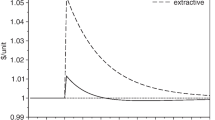Abstract
Technological innovations have been investigated by means of substitution and diffusion as well as evolution models, each of them dealing with different aspects of the innovation problem. In this paper we follow the well known research traditions on self-organisation models of complex systems. For the first time in the literature we show the existence of a specific niche effect, which may occur in the first stage of establishment of a new technology. Using a stochastic Master equation approach, we obtain analytical expressions for the survival probabilities of a new technology in smaller or larger ensembles. As a main result we demonstrate how a hyperselection situation might be removed in a stochastic picture and thresholds against the prevailing of a new technology in a step-by-step process can be overcome.
Similar content being viewed by others
References
Alchian A (1950) Uncertainty, Evolution and Economic Theory. J Political Econ 58: 211–221
Allen PM (1975) Darwinian Evolution and a Predator-Prey Ecology. Bull Math Biol 37: 389–405
Allen PM (1976) Evolution, Population Dynamics, and Stability. Proc National Academy of Sciences of the USA 73: 665–668
Allen PM, Ebeling W (1983) Evolution and the Stochastic Description of Simple Ecosystems. BioSystems 16: 113–126
Allen PM (ed) (1986) Management and Modelling of Dynamic Systems. Eur J Oper Research 25: 1
Allen PM, Clark N, Perez-Trejo F (1992) Strategic Planning of Complex Economic Systems. Rev Political Econ 4: 275
Arthur BW (1989) Competing Technologies, Increasing Returns, and Look-In by Historical Events. Economic J 99: 116
Ayres RU (1991) Evolutionary Economics and Environmental Imperatives. Structural Change Econ Dynamics 2: 255
Bartholomay AF (1958) On the Linear Birth and Death Processes of Biology as Markoff Chains. Bull Math Biophysics 20: 97–118
Bartholomay AF (1958) Stochastic Models for Chemical Reactions. I. Theory of the Unimolecular Process. Bull Math Biophysics 20: 175–190
Bartholomay AF (1959) Stochastic Models for Chemical Reactions. II. The Unimolecular Rate Constant. Bull Math Biophysics 21: 363–373
Batten D (1982) On the Dynamics of Industrial Evolution. Regional Sci Urban Econ 12: 449–462
Bhargava SC (1989) Generalized Lotka-Volterra Equations and the Mechanism of Technological Substitution. Technol Forecasting Social Change 35: 319–326
Bruckner E, Ebeling W, Scharnhorst A (1989) Stochastic Dynamics of Instabilities in Evolutionary Systems. System Dynamics Rev 5: 176–191
Bruckner E, Ebeling W, Scharnhorst A (1990) The Application of Evolutionary Models in Scientometrics. Scientometrics 18: 21–41
Dosi G, Freeman C, Nelson R, Silverberg G (eds) (1988) Technological Change and Economical Theory. Francis Pinter, London
Dosi G, Kaniovski Yu (1993) The Method of Generalized Urn Scheme in the Analysis of Technological and Economic Dynamics. IIASA Working Paper WP-93-17
Easingwood C, Mahajan V, Muller E (1981) A nonsymmetric Responding Logistic Model for Forecasting Technological Substitution. Technol Forecasting Social Change 20: 199–213
Ebeling W, Feistel R (1982) Physik der Selbstorganisation und Evolution. Akademie-Verlag, Berlin
Ebeling W, Sonntag I, Schimansky-Geier L (1981) On the Evolution of Biological Macromolecules. II. Catalytic networks. Studia Biophysica 84: 87
Eigen M (1971) The Self-organization of Matter and the Evolution of Biological Macromolecules. Naturwissenschaften 58: 465
Eigen M, Schuster P (1977, 1978) The Hypercycle. Naturwissenschaften 64: 541–565, 65: 341
Feistel R, Ebeling W (1976) Dynamische Modelle zum Selektionsverhalten offener Systeme. Wisse Z Wilhelm-Pieck-Universität Rostock 25: 507–513
Fisher JC, Pry RH (1971) A Simple Substitution Model of Technological Change. Technol Forecasting Social Change 3: 75–88
Haken H (1983) Advanced Synergetics. Springer, Berlin Heidelberg New York
Hofbauer J, Sigmund K (1984) Evolutionstheorie und dynamische Systeme. Paul Parey, Hamburg
Jiménez Montaño MA, Ebeling W (1980) A Stochastic Evolutionary Model of Technological Change. Collective Phenomena 3: 107–114
Karmeshu, Bhargava SC, Jain VP (1985) A Rationale For Law of Technological Substitution. Regional Sci Urban Econ 15: 137–141
Kwasnicka H, Galar R, Kwasnicki W (1983) Technological Substitution Forecasting with a Model Based on Biological Analogy. Technol Forecasting Social Change 23: 41–53
Mahajan V, Peterson RA (1979) First-Purchase Diffusion Models of New-Product Acceptance. Technol Forecasting Social Change 15: 127–146
Mosekilde E, Aracil J, Allen PM (1988) Instabilities and Chaos in Non-linear Dynamical Systems. System Dynamics Rev 4: 14–55
Nelson R, Winter SG, Schuette H (1976) Technical Change in an Evolutionary Model. Q J Econ 90: 90
Nelson R, Winter SG (1982) An Evolutionary Theory of Economic Change. The Belknap Press of Harvard University Press, Cambridge, Mass, London
Nicolis G, Prigogine I (1987) Die Erforschung des Komplexen: auf dem Weg zu einem neuen Verständnis der Naturwissenschaft. Piper, München Zürich
Prigogine I, Nicolis G, Babloyantz A (1972) Thermodynamics and Evolution. Physics Today 25: 38
Saviotti PP, Mani GS (1993) A Model of Technological Evolution Based on Replicator Dynamics. International Conference on New Developments in Technology Studies: Evolutionary Economics and Chaos Theory. Amsterdam
Saviotti PP, Metcalfe JS (eds) (1991) Evolutionary Theories of Economic and Technological Change. Harwood Academic, Chur
Schimansky-Geier L (1980) Stochastische Theorie der Nichtgleichgewichtsphasenübergänge in einkomponentigen bistabilen chemischen Reaktionssystemen. Dissertation, Humboldt-Universität, Berlin
Schumpeter JA (1912) Theorie der wirtschaftlichen Entwicklung. Duncker-Humblot, Leipzig
Sharif MN, Kabir CA (1976) Generalized Model for Forecasting Technological Substitution. Technol Forecasting Social Change 8: 353–364
Silverberg G (1984) Embodied Technical Progress in a Dynamic Economic Model: The Self-Organization Paradigm. In: Goodwin RM et al. (Eds.) Non-linear Models of Fluctuating Growth. Springer, Berlin Heidelberg New York
Silverberg G (1992) On the Complex Dynamics of Technical Change and Economic Evolution. J Scientific Industrial Res 51: 151–156
Tingyan X (1990) A Combined Growth Model for Trend Forecasting. Technol Forecasting Social Change 38: 175–186
Troitzsch KG (1993) Evolution of Production Processes. In: Haag G, Troitzsch KG (eds) Economic Evolution and Demographic Change. Springer, Berlin Heidelberg New York, pp 96–112
Weidlich W, Haag G (1983) Concepts and Models in Quantitative Sociology. Springer, Berlin Heidelberg New York
Weidlich W, Braun M (1992) The Master Equation Approach to Nonlinear Economics. J Evol Econ 2: 233–265
Author information
Authors and Affiliations
Rights and permissions
About this article
Cite this article
Bruckner, E., Ebeling, W., Montaño, M.A.J. et al. Nonlinear stochastic effects of substitution — an evolutionary approach. J Evol Econ 6, 1–30 (1996). https://doi.org/10.1007/BF01202370
Issue Date:
DOI: https://doi.org/10.1007/BF01202370




